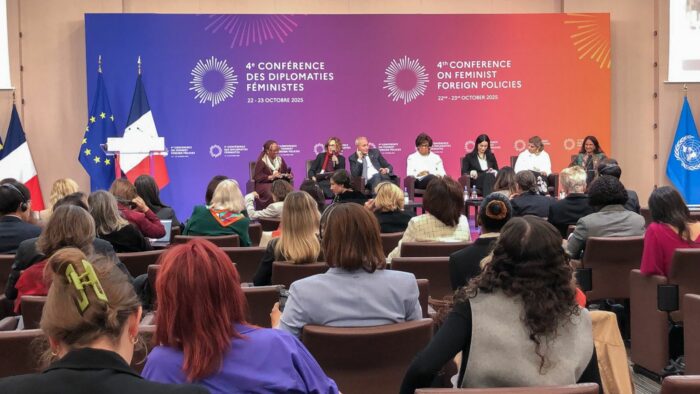The Progressive Post
A gender perspective of the parliamentary elections in Lithuania

It is difficult to explain Lithuania’s political landscape in a conventional way as the whole spectrum of political parties is skewed to the right. As a result, there is a constant danger that human rights, and particularly women’s reproductive rights, could be violated. A low number of women with seats in parliament has always been a great obstacle to achieving advances in gender equality and other human rights issues.
Lithuania’s parliament (called the ‘Seimas’) consists of 141 parliamentarians. They are elected through a parallel voting process, with 71 members elected in single-seat constituencies and 70 members elected by proportional representation. Through proportional representation, voters are able to list up to five candidates from a selected party and give a single preference vote for each of them. The final list of candidates is formed entirely according to the numbers of the preference votes received. To be eligible for seats and enter into parliament, parties have to attain at least a five percent threshold.
In the outgoing Seimas, 34 of the 141 seats were held by women (23.1 percent). In the recent elections, 38 women have been elected – the highest number since restoration of the country’s independence (Figure 1).
In general, the changes in the numbers of female parliamentarians follow an apparent trend of up and down, similar to a sine wave. In most cases, this can be explained by the activities of NGOs: whenever the number of women in the Seimas has decreased after an election, women’s NGOs have raised concern, and thus attracted more attention to the representation of women. Parties have then usually ‘followed the wishes of the electorate’ and nominated more women on their electoral lists.
Figure 1. Women and men in the Seimas of the Republic of Lithuania 1990-2020, in percentage.
In 2020, a total of 17 political parties participated in the elections. In the single-seat constituencies, there were 23 independent candidates who stood on their own. On average, the percentage of women on the electoral lists of the parties was 33.6 percent. The percentage of female candidates put forward by parties in the single-seat constituencies amounted to 26.6 percent. The highest percentage of female candidates (62.9 percent) were fielded by the ‘Electoral Action of Poles in Lithuania – Christian Families Alliance’ party – but this did not help the party achieve the required five percent threshold. Three of this party’s candidates won the elections in single-seat constituencies, of which three are women.
Percentages of women on the lists of other parties ranged from 15.9 to 42.6 percent. Among the top ten candidates of the lists, there were from 0 zero to 5 five women. The highest number of women among the top ten were on the list of the Social Democratic Party of Lithuania (5), and the lowest number on the list of the ‘National Unity’ party (0). This party also had the lowest representation of women on the entire electoral list. A total of six parties had only one woman in the top ten, and only one of them succeeded in attaining the five percent threshold.
The utmost attention needs to be paid to the elected parties and to the potential members of the new ruling coalition. Six parties achieved the five percent threshold of votes and are thus able to form their factions in the Seimas (more than seven seats). These six parties are:
Homeland Union – Lithuanian Christian Democrats, 50 seats, 14 women.
Lithuanian Farmers and Greens Union, 32 seats, 16 women.
Liberal Union, 13 seats, 1 woman.
Social Democratic Party of Lithuania, 13 seats, 4 women.
Freedom party, 11 seats, 6 women.
Labour Party, 10 seats, 2 women.
Eleven more parliamentarians, including two women, were elected in single-seat constituencies.
The ruling coalition will be centre-right and composed of three parties: the Homeland Union – Lithuanian Christian Democrats (TS-LKD), the Liberal Union and the Freedom Party. This coalition will have a minimal majority (74), unless some of the 11 parliamentarians who were elected in single-seat constituencies join them.
The most important factor for women in this coming legislative period is that all three future ruling coalition parties are led by women – and very charismatic ones at that. To be precise, the chairperson of the TS-LKD is a man, but the real guiding force of party policy is a non-partisan member of the TS-LKD faction in the Seimas, Ingrida Simonyte. Formerly the minister of finance in the TS-LKD government, and then nominated by the party to be a candidate in the presidential elections (where she took second place), Simonyte won a single-seat constituency in the first round of these elections.
TS-LKD skilfully and successfully announced in advance that, if they won, the prime minister would be Ingrida Simonyte, their the most popular policymaker. Indeed, Simonyte also has a significant number of supporters (mostly women) in the party itself who partly compensate for the views of the party’s radically conservative wing.
Given that both liberal parties have very progressive cultural values, it seems there are no grounds for concern about worsening conditions for gender equality or other human rights issues. But if progress can be expected is difficult to predict. A possible area for concern is that there will not be enough votes to ratify the Istanbul Convention for instance or to adopt a law on same-sex civil partnerships.
During the electoral campaign, these two questions have been frequently debated, and only three of the parliamentary parties expressed any commitment to them: the Social Democratic Party, the Liberal Union, and the Freedom Party. The same parties (just three of 17) were also the only ones to mention gender equality and human rights questions in their electoral programmes. A new feature of this election campaign was that for the first time ever issues of gender equality, human rights, and women’s political participation were among the most earnest questions under discussion. Many of the other parties, however, did not wish to recognise these problems, tried to avoid discussions and argued that these issues were not important. Consequently, and perhaps rightly, these parties were not elected to the Seimas.
The results of the Social Democratic Party in these elections need to be analysed. Before the election campaign, there was an air of general optimism. From the perspective of gender equality, the electoral programme sounded quite promising and the placement of five women in the top ten electoral lists was encouraging. Yet only eight seats were won in the proportional system (13 seats in total).
The right-wing parties in fact appropriated the Social Democratic agenda and exploited it during the campaign. While the gender pay gap, universal kindergarten access, women’s political participation, violence against women, and equal opportunities in education are all issues that are part of the core agenda of social democracy, they were loudly announced as slogans of the right-wing parties. And the electorate believed them. Why did people not believe the Lithuanian Social Democrats?
Possibly, this is due to unfulfilled promises in the past. The LGTB community provided more support for the Freedom Party and the Liberal Union in these elections – perhaps because they felt that in the past, promises of the Lithuanian Social Democrats were sometimes not met? Why did women not believe the Social Democratic promises on gender equality? Perhaps they are under the impression that the Social Democrats do not obey their own norms? The Social Democratic party is the only party in Lithuania that has imposed a statutory quota in the electoral lists – no more than 60 percent of either sex. But the electoral list in these recent elections had only 33.6 percent of women. Could this be a reason not to believe in the overall sincerity of Social Democrats?
We Social Democrats have to learn from these results, to start preparations for the next elections and to finish our party’s renewal process, to grow our left-wing electorate, to fight for the values and tenets of social democracy and, quite frankly, keep our promises. Ultimately, we have to learn from these results in order to win the next elections.
Related articles:




